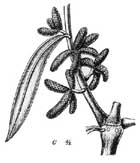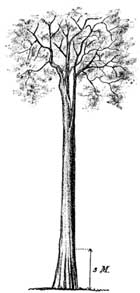
Twigs with pollen cones (from Koord. Atlas 3, 1915, t. 590) (1).

Twigs with pollen cones, and microsporophyll (from Koord. Atlas 3, 1915, t. 590) (1).
Common Names
A great many native names (listed in (1)), reflecting its broad Malesian distribution. In Australia it is called black pine (1).Taxonomic notes
Syn: Podocarpus amara Blume 1827; Podocarpus eurhyncha Miq. 1856; Podocarpus dulcamara Seem. 1861; Nageia amara (Blume) O.K. 1891; Nageia eurhyncha (Miq.) O.K. 1891; Podocarpus pedunculata Bailey 1899; Stachycarpus amara Gaussen 1973 (1).Description
"Tree 10-60 m high, 12-140 cm diam. Bark surface checkered by numerous cracks. Cotyledons 3 fused pairs. Foliage buds small, globose, with overlapping, rounded, keeled scales up to 2 mm long. Juvenile leaves oblong, 4-12 by up to 2 cm, more or less abruptly narrowing at the base to a 3-5 mm long petiole, narrowing abruptly at the apex to an elongated tapering 'drip tip' which is c. 2 mm wide and up to 20 mm long, apex rounded to acute. Mature leaves becoming longer and narrower, linear, narrowed at the base to a c. 5 mm long petiole, usually slightly acuminate and acute, a distinct groove over the midvein above, broadly raised below, 5-15 cm by 6-14 mm. Pollen cones 15-35 by 2.5-3.5 mm, solitary and terminal or grouped to at least seven on an auxillary 1-7 mm peduncle with several sterile basal scales. Apex of microsporophyll acute, triangular, keeled, c. 0.8 mm long. One to several ovules scattered laterally along a 3-5 mm scaly shoot, the scales triangular to rounded, decurrent, spreading, 1.5-2 mm long, the sterile scales deciduous. Ovule and its covering oval, longer than its bract (fertile scale) and distinctly crested at its apex, dark blue and glaucous. Growing seed and its covering elongated at both the micropylar end and the forwardly bent apex; mature seed and its covering nearly spherical, with a small obtuse crest, c. 25 mm diam., becoming reddish and then dark purple and glaucous. Seed c. 20 mm diam., with an indistinct ridge and minute apiculus formed from the micropyle, the smooth outer hard shell c. 1 mm thick, the fleshy covering c. 3 mm thick becoming wrinkled as it dries and often falling off""A few times it is mentioned that the tree is buttressed (Pinosok Plateau and Mt Cyclops, New Guinea), or spurred, a rare feature in Podocarpaceae" (1).
Range
Australia: NE. coastal Queensland; "through and very common in New Guinea (incl. New Britain & New Ireland), Moluccas (Buru, Halmaheira, Morotai), Lesser Sunda Islands (Timor, Flores, West Sumbawa, Lombok), throughout Java, Central and SW Celebes (Bonthain), Philippines (Mindanao, Luzon), Borneo (only in Sabah!), and Sumatra (Central-N., Batak region, rare in S. Palembang). ... Scattered and often common in primary and secondary rain-forest, in New Guinea very common, often in Fagaceous forest, sometimes in mossy forest, in submontane forest at c. 900 m with Dysoxylum, Macaranga, Ficus, sometimes emergent as a colossal tree, often on latosols, rarely on sandy soils or on marshy ground, (sea-level-)500-2000(-2300) m, according to Smythies (in sched.) to 3000 m in Sabah" (1).Big Tree
Oldest
Dendrochronology
Ethnobotany
"A fine timber tree, often of large dimension. In New Guinea mentioned to be used for joinery and furniture" (1).Observations
Remarks
"The leaves are variously reported as bitter ('amara'), to which also the Sundanese name 'pait' refers, bittersweet ('dulcamara'), or sweet tasting. This and the groove over the midvein most readily distinguishes it from similar-leaved associated Podocarpus species while the lack of hypoderm also gives a distinct texture to the leaves. The striking form of the juvenile leaves led to the description of Podocarpus eurhyncha. Gray & Buchholz (1951) report that the leaves occasionally have a lateral pair of vascular resin canals in addition to the conspicuous central canal beneath the vascular bundle. Two collectors report seeds with distinctive sculpturing on their surface but this is not evident in the corresponding preserved specimens. The normally three rather than two fused pairs of cotyledons is unique" (1).Citations
(1) de Laubenfels 1988.See also de Laubenfels 1978.
[Prumnopitys] [Podocarpaceae] [home]
This page is from the Gymnosperm Database
URL: http://www.geocities.com/RainForest/Canopy/2285/po/pr/amara.htm
Edited by Christopher J. Earle
E-mail:earlecj@earthlink.net
Last modified on 21-Dec-98
